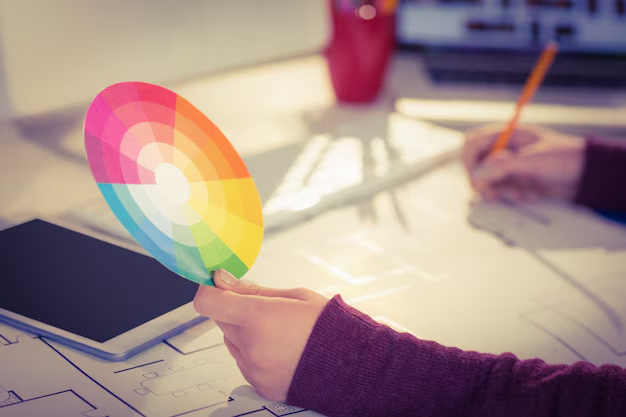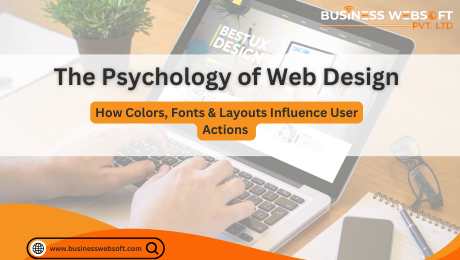When you go to a website, what makes you stay, explore, or leave within seconds? The answer lies in psychology-driven web layout—a aggregate of colors, typography, and layout alternatives that have an effect on consumer feelings and movements. A properly-designed website doesn’t simply appearance precise; it guides visitors towards making choices, whether or not it’s signing up, shopping a product, or attractive with content.
In this blog, we’ll explore the mental effect of web layout elements and how agencies can use them to enhance person revel in,growth engagement, and drive conversions.
1. The Power of Colors in Web Design
Colors are more than just aesthetic choices; they evoke emotions, build brand identity, and impact user behavior. Different colors trigger different psychological responses.
🔹 Common Color Associations in Web Design:
- Red – Creates a sense of urgency and excitement. Often used in sales and promotions (e.g., Coca-Cola, YouTube).
- Blue – Represents trust and professionalism. Ideal for finance and healthcare brands (e.g., PayPal, Facebook).
- Green – Associated with health, nature, and tranquility. Used in wellness, organic, and eco-friendly brands (e.g., Whole Foods).
- Yellow – Evokes happiness and optimism. Common in call-to-action buttons to grab attention.
- Black & White – Minimalistic and elegant. Used by luxury brands and professional websites (e.g., Apple, Chanel).

🔹 How to Use Colors Effectively in Web Design:
✅ Choose colors that align with your brand personality and message.
✅ Use contrast wisely to make text readable and highlight important sections.
✅ Apply color psychology to influence emotions and drive actions (e.g., red for urgency, green for trust).
2. Typography: How Fonts Shape User Perception
Typography is more than just choosing a font; it’s about communicating your brand’s personality and improving readability.
🔹 The Psychology Behind Different Font Styles:
- Serif Fonts (Times New Roman, Georgia): Convey tradition, trust, and reliability. Often used in news and academic websites.
- Sans-Serif Fonts (Arial, Helvetica, Open Sans): Modern, clean, and easy to read. Preferred for tech and corporate brands.
- Script Fonts (Lobster, Pacifico): Elegant and creative but should be used sparingly for headings or logos.
- Monospace Fonts (Courier, Consolas): Give a retro or coding-related aesthetic. Used in developer and tech-related websites.
🔹 Best Practices for Using Fonts in Web Design:
✅ Stick to two or three complementary fonts to maintain consistency.
✅ Ensure fonts are readable across all devices and screen sizes.
✅ Use hierarchy (bold, italics, and different sizes) to guide user attention to key content.
3. Layout and User Behavior: The Science Behind Website Structure
The way information is structured on a webpage influences how users navigate, engage, and convert.
🔹 Key Psychological Principles in Layout Design:
- The F-Pattern: Users scan pages in an “F” shape—starting from the top-left, moving horizontally, and then scanning vertically. Place key content (e.g., headlines, CTAs) in this path.
- The Z-Pattern: Common in landing pages, users follow a “Z” path from left to right, then diagonally, and back to the right. Effective for guiding user flow to CTAs.
- Whitespace (Negative Space): Helps reduce clutter, improves readability, and makes designs feel more premium.
- Visual Hierarchy: Placing elements strategically to direct attention—biggest, boldest, and most colorful elements get noticed first.
🔹 Tips for an Effective Website Layout:
✅ Keep designs simple and intuitive—users should find what they need within seconds.
✅ Use clear CTA buttons with contrasting colors to drive action (e.g., “Buy Now,” “Sign Up”).
✅ Ensure mobile-friendly layouts—over 60% of web traffic comes from mobile devices.
4. Trust and Credibility: The Psychological Role of Design Elements
A website’s design plays a crucial role in building trust with users. If a site looks outdated, cluttered, or unprofessional, visitors are less likely to engage or make a purchase.
🔹 Elements That Build Trust:
✅ Professional, clean design: First impressions matter—75% of users judge a website’s credibility based on its design.
✅ Consistent branding: Colors, fonts, and tone should match across all pages.
✅ Fast load times: 53% of users leave a site if it takes longer than 3 seconds to load.
✅ Secure website (HTTPS): People are hesitant to share personal information on non-secure sites.
✅ Testimonials and social proof: Show customer reviews, ratings, and brand partnerships to establish credibility.
5. Call-to-Action (CTA): How to Persuade Users to Take Action
A strong, well-placed CTA can significantly impact conversions. The wording, placement, and design of CTAs influence whether users click, sign up, or buy.
🔹 CTA Best Practices:
✅ Use action-oriented language (e.g., “Get Started,” “Claim Your Free Trial,” “Shop Now”).
✅ Make CTAs stand out using contrasting colors and bold fonts.
✅ Place CTAs strategically—above the fold, at the end of articles, and within scrollable content.
✅ Create a sense of urgency (e.g., “Limited Offer – Sign Up Today!”).
Conclusion: Designing for Emotion, Engagement, and Conversions
Web design is not just about aesthetics—it’s about understanding human psychology and creating experiences that resonate with users. From the colors you choose to the fonts and layout, every element plays a role in influencing behavior.
By leveraging psychology-driven design principles, businesses can:
✅ Enhance user engagement
✅ Build brand trust and credibility
✅ Increase conversions and sales
Is your website designed with psychology in mind? Let us know your thoughts in the comments below! 🚀
